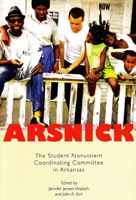Book Chronicles Arkansas’s Civil Rights Beyond Central High
The University of Arkansas Press has released a new book co-edited by UALR Donaghey Professor of History and Chair John A. Kirk on the Student Nonviolent Coordinating Committee’s Arkansas project to integrate businesses, schools, and other public facilities in Arkansas.
 The book, “Arsnick: The Student Nonviolent Coordinating Committee in Arkansas,” chronicles the history of SNCC’s Arkansas Project from 1962 to 1967. “Arsnick,” as the organization was sometimes known in Arkansas, organized sit-in demonstrations at segregated businesses to take a stand against racial discrimination.
The book, “Arsnick: The Student Nonviolent Coordinating Committee in Arkansas,” chronicles the history of SNCC’s Arkansas Project from 1962 to 1967. “Arsnick,” as the organization was sometimes known in Arkansas, organized sit-in demonstrations at segregated businesses to take a stand against racial discrimination.
Several former Arsnick activists will participate in the symposium “Sit-Ins, Freedom Rides, and Beyond Direct Action and Civil Rights in 1960s Arkansas” from 9 a.m. to 6 p.m. Saturday, July 9, at the Mosaic Templars Cultural Center at 501 West 9th St. in downtown Little Rock. The symposium is free and open to the public.
SNCC grew out of the southern student sit-in demonstrations that began on Feb. 1, 1960, in Greensboro, N.C. Within a year, the sit-in movement had swept through more than 100 southern cities and involved more than 70,000 activists.
The sit-ins began in Little Rock in 1960, when a group of Philander Smith students began to sit at lunch counters in downtown restaurants, demanding equal service. At the time, segregation forced blacks to use separate facilities from whites. Often there were no segregated facilities provided for them at all.
Initially, the movement met with harsh fines and stiff sentences. SNCC worker Bill Hansen, a young white Ohioan, arrived in Little Rock in 1962 at the request of the Arkansas Council on Human Relations, revived the sit-in movement. Desegregation of downtown facilities became a reality in 1963.
In the years that followed, many more SNCC volunteers came to the state to set up projects across the Arkansas Delta to help empower local people to take a stand against racial discrimination.
In the five short years before it disbanded, SNCC’s Arkansas Project played a pivotal part in transforming the state. Yet this fascinating episode in civil rights history has barely garnered a footnote in the literature of the movement.
“Arkansas has a rich, deep and complex civil rights history that stretches well beyond the events at Central High,” Kirk said. “The sit-ins and Freedom Rides launched the 1960s civil rights movement in the United States and Arkansas.
The new book serves as a corrective by bringing together articles on SNCC’s activities in Arkansas for the first time, by providing powerful firsthand testimonies, and by collecting key historical documents from SNCC’s experiences in the state.
Kirk has authored several books on the 1960s civil rights movement including “Beyond Little Rock: The Origins and Legacies of the Central High Crisis,” “Martin Luther King, Jr. and the Civil Rights Movement: Controversies and Debates;” and “Redefining the Color Line: Black Activism in Little Rock, Ark., 1940-1970.”
Kirk co-edited “Arsnick” with Jennifer Jensen Wallach, assistant professor of history at the University of North Texas.
“Arsnick” is available for purchase at the UA Press website and at amazon.com.